
Pain management means finding ways to lower or control pain. It doesn't always mean making the pain go away completely, but it helps you feel better and live your life more fully.
There are many ways to manage pain. Doctors might give medicine, suggest physical therapy, or offer other treatments. Some people use a mix of things, like exercise, massage, or counseling.
Pain can be short-term (like after surgery) or long-term (like arthritis). For each kind, there are different ways to help. Pain management is not the same for everyone—it depends on the kind of pain and how it affects your daily life.
If your pain is getting in the way of your day, talk to your doctor. You don’t have to live in pain—there are many ways to feel better.
Pain doesn’t always go away with rest or time. That’s when pain management becomes necessary. If pain affects your sleep, work, or mood, it’s time to get help.
Some people live with long-term conditions like:
Others might need help after surgery or accidents. Even small pains that last a long time can become serious. Pain can be physical, emotional, or both. When pain lingers, it affects your whole life.
Don’t ignore pain. Getting help early can stop it from becoming worse. Talk to a pain doctor or specialist. With the right care, you can feel better.
There are many health professionals who can help with pain. The right one depends on your pain and what’s causing it.
A team approach is often best. Your doctor may work with others to make a full pain plan just for you. They may also refer you to a pain clinic.
Always be honest about your pain when talking to your doctor. That way, they can find the best help for you.
Pain can be managed in many ways. Not every method works for everyone, so doctors often mix treatments to find what helps you the most.
Each method has its pros and cons. Some are fast, while others take time. Your doctor will help you find a plan that fits your needs.
A pain management strategy is a plan created to help you feel better. It often includes a mix of treatments based on your pain, your body, and your life.
You and your doctor work together to build this plan. You may try one thing, then add or change it over time.
Pain management is a journey. With the right strategy, it gets easier.
Like all treatments, pain management has risks and benefits. Knowing both helps you make better choices.
Most people do well with the right help. Your doctor will talk with you about these risks and how to avoid them.
Pain can come from many places in the body. It can be due to injury, illness, or even stress.
Sometimes, pain has no clear reason. That doesn’t mean it isn’t real.
Treating the cause can often reduce the pain.
Pain doesn’t just hurt. It also affects how your body works.
If pain lasts a long time, it can hurt your health in many ways. That’s why it’s important to treat it early.
You don’t always need pills to feel better. There are many natural ways to manage pain.
These methods may take time, but they often help you feel better without side effects.
Pain medicines can help, but they sometimes cause problems.
Over-the-counter meds like ibuprofen or acetaminophen are safer, but still need care. Too much can hurt your liver or stomach.
Pain medicine helps, but always use it carefully.
Pain is real, and it can take over your life. But with the right help, you can take control again. Pain management gives you tools, support, and hope. You don’t have to suffer in silence. Whether your pain is new or has been around for years, there are ways to feel better.
Take the first step. Reach out, ask for help, and start your journey toward feeling better today.
Pain management means using treatments to reduce or control pain. It can include medicines, exercises, therapy, or natural methods. The goal is not always to make pain disappear but to help you live a better, more comfortable life. Pain management is different for each person depending on their needs.
The three main types are:
Many people use a mix of these to get the best results. Your doctor can help find what works for you.
The 4 P’s of pain management are:
Using all four together helps manage pain in a better way.